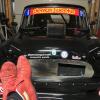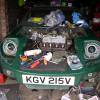The Problem
For me, the one thing missing from Mini development either from the factory or aftermarket is the application of an anti-lock brake system. As a community we have been able to extract considerably more power from our cars than they were ever given in standard form, an 80+bhp engine can be bought off the shelf, the application of turbos, twice the valves or full engine swaps means we have classic cars that can keep up with or embarrass their modern counterparts, but they can’t stop like them. Our driving style has to be different to compensate for this and we have cars that can handle their way out of trouble. But this also means that when we need to stop quickly we REALLY need to stop quickly.
The brakes on our cars are generally quite good, the standard 2 pot disc brakes do a good job and the cars light weight means that job is done efficiently, but they can also be easily locked up giving a loss of control. Cadence braking has been the prescribed solution to this scenario but this takes presence of mind in a panic situation and if applied properly it can generally get you out of trouble at the cost of a slightly increased braking distance. The problem is having the presence of mind in a situation where the natural intuitive human reaction is to press down harder on the brake pedal. This can be compounded when the Mini is not the regular daily drive but rather a modern car with an ABS system is what the driver’s more used to. How many of us now automatically apply the clutch in a hard braking situation, regardless of the vehicle you’re in?
Anybody who has contemplated the retro-fitting of an ABS system to their Mini will be acutely aware of the complexity these systems employ, the expense required and the difficulty in mating the necessary parts to such an old design which is probably why it has never been done. The system I am proposing strips back the complexity down to the basic requirement of cadence braking as a result of the natural driver reaction to an emergency braking situation.
The Challenge
Is it possible that we can, as a forum or the wider Mini community develop an automated braking system that delivers safer emergency braking better than human effort? Is there the knowledge and experience amongst us to identify and specify the necessary components and to be able to design the control system? Can we collaboratively come up with a cost effective DIY solution that not only Mini owners can feel confident in but also give an option to all classic car drivers who feel they could benefit from such a system?
Design brief
To develop an automated cadence braking system that performs better than the equivalent human method. It must be triggered by natural intuitive operator input thus shortening or removing the current reaction time to a given emergency braking situation.



















